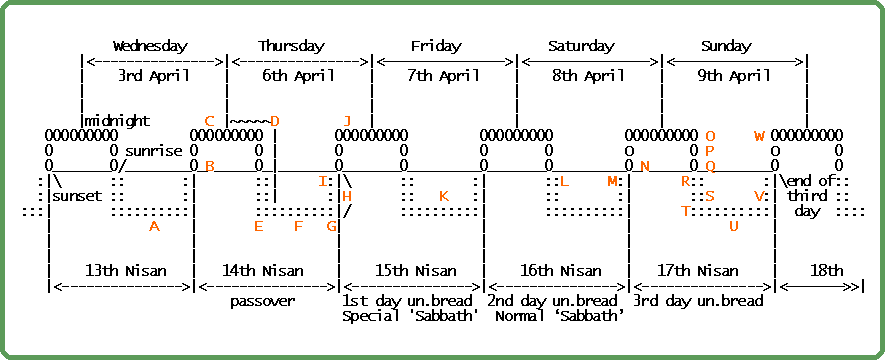EVENTS DURING PASSOVER in 30ad

|

Maurice Lloyd Glasgow
COMMENTS ON THE PASSOVER WEEK DIAGRAM
1. The year AD30 has been tested from many independent facts. being based on the birth of Jesus at the Feast of Tabernacles BC4, the death of Herod early in BC3, the attainment of the age of 30 by Jesus Tistra of AD27 when he proclaimed the 29th Jubilee in the Synagogue at Nazareth, a ministry of 2.5 years [the number of 'witness'!] and some secular dates which conform to it. CB.App.179.
2. The pharisaic teaching on the Passover as given by Edershein and Josephus, deviates from the Mosaic order, which was held by the Sadduces, the Raraites and still to-day by the Samaritans. All parties show the Pascal Lamb during the 14th Nisan, but the Pharisaic Jews then [and most Jews now] celebrated the feast on the 15th. This is due to interpreting the term "between the evenings", see Newberuy's notes or ASV notes. The true meaning is the brief time between sundown and twilight when, in the old Temple the lamp was to be lit. The Pharisaic tradition changed this to mean between early afternoon and sunset; so it resulted in eating the passover on the 15th in stead of on the 14th.[These short comments belie the immense research needed to investigate this confusing issue.]
3. I differ from those who insist that "three days and three nights" have to be taken literally. Appendix 144 in the Companion Bible implies that Bullinger taught this; but the work was completed by another person. What Bullinger certainly taught can be found on psages 845-847 of "Eigures of Speach". Here he shows it is an idiom for three days with intervening nights. A 72hour period cannot conform to the phrase: "after these days".
4. There were three different groups of women and visits to the tomb. At the close of the Sabbath day [point M] certain women including Magdalene visited. It is deduced that Mary Magdalene returned in order to purchase spices after the Sabbath with the other two, as per Mark 16. Some women stayed on and saw the stone rolled away as the Sabbath day ended. Mary Magdalene was not one of them but did join those who visited the tomb in the small hours [point O]. She was not with the two [her co-purchasers] who went to the tomb "after the sun had risen" [point R].
5. Jesus rose from the dead in the first daylight hour of the Sabbath. I affirm this because that is what Mark 16:9 strictly says. The word Sabbaton means "of sabbath" [week is represented by SabbatOn in the plural]. PrOi means the early part of the day. PrOtEi means the first of an implied feminine noun, which has to be "hour" of a sabbath day.
6. I take the "young man" in both Mark 14:51 and 16:5 to be the gospel writer himself. As the frightened women ran from the tomb "they said nothing to anyone", so only Mark was in a position to record the incident. It may be noted that their conversation was overheard by Mark as their heads were down walking towards the rising sun, only looking up at the last moment to observe the stone already rolled away. This fact tells against the traditional sight of the tomb, since the city wall would have obscured the sun. It does accord well with the 'garden tomb' site.
7. Although this is speculation, the unnamed "other women" may well have been the two young sisters of Jesus. My construction has the two Marys meeting Salome at the tom at the end of the Sabbath day. It would be natural for Salome, their aunt, to take them along with her; it would be natural that instead of promptly returning they instead lingered; it is noticeable in the Angel's words to them a condescending tone as if to young girls, especially his: "Lo! I have told you". It would be likely that they would not be able to locate the disciples and perhaps get lost in the darkness. It would be characteristic that Jesus would make a special Journey to find them and redirect them to His brothers, whom they would more easily find. It would be characteristic that as their own elder brother they would familiarly clutch at His feet. The salutation is doubtless a translation into Greek from Hebrew [in which Matthew is reputed to have written]. Thus it would have been 'Shalom' rather than c airete At this time their mother was in the care of John The Beloved. The UBS Hebrew New Testament has 'Shalom' in Matthew 28:9.
M.L.Lloyd Glasgow July 1991